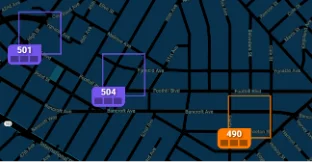Law enforcement agencies often consider police patrol software because of the following challenges:
- Crime analysts, bogged down by hours of manually analyzing data and compiling reports, lack the time and bandwidth to focus on the higher-priority initiatives where their skill and expertise may be better utilized.
- Beat officers, navigating staffing shortages and high crime rates, spend the bulk of their time responding to calls, and often do not have an efficient way to be able to determine the optimal locations where they should spend uncommitted time. As a result, they can resort to “gut-based” patrolling, in which they conduct patrols at locales based on personal intuition and prior experience, and not data. This type of approach has not proven to be successful in reducing crime and can result in the community feeling over-policed and discriminated against.
- Line-level supervisors and command staff have no reliable way of knowing where their officers are focusing uncommitted time and what types of proactive activities they are engaging in to deter crime, and this lack of accountability puts them at risk of minimized crime deterrence and increased scrutiny from the community.
- Given the reality of resource-constrained departments, high crime rates, and community complaints, command staff can find their agencies lacking an effective communication method to mobilize and align patrol resources around rapidly developing crime activities or special assignments, putting community safety at risk.
- Command staff can lack the bandwidth needed to implement proactive crime reduction initiatives, preventing crime from being addressed at a more holistic, impactful level.
Note: ResourceRouter was built to solve all the pain points identified above. You can read about it in detail below or reach out to our sales team if you want to see exactly how it can help improve your agency’s approach to patrol management.
What is Police Patrol Software?
Police patrol software applications are designed to help law enforcement agencies better deploy and direct officer resources in the field in order to maximize their impact.
For agencies struggling with these and other resource-related pain points, the best next step is to find a police patrol software system that uses AI and machine learning to direct officers to locations with the highest areas of risk that are both crime- and time-specific. This type of technology maximizes limited and strained resources and is designed to deter crime before it occurs.
In this post, we’ll provide an overview of ResourceRouter™, and then review all the factors you should consider when deciding on a police patrol software system for your agency.
ResourceRouter Police Patrol Software
ResourceRouter is a patrol and analyst tool that automates the planning of directed patrols for Part 1 crime data across an entire jurisdiction, daily. With ResourceRouter, analysts and supervisors review pre-generated directed patrol assignments that ensure officers are at the right place at the right time to maximize crime prevention while also guarding against over and under-policing. Dynamic patrol location forecasts, precise risk assessments. and pre-patrol briefings help facilitate optimal outcomes even with limited staffing and resources.
Police Patrol Software Key Feature # 1: Automated Crime Patrol Plans Free Up Bandwidth and Resources for Other High-Priority Initiatives
Agencies assessing police patrol software should consider a product that includes automated directed patrol planning, as manual hotspot analysis can take up hours of a crime analyst’s time per week, quickly become outdated, and ultimately steer away analyst resources from other high-priority initiatives where their skill and expertise may be better utilized.
ResourceRouter utilizes historic crime data as well as objective non-crime data to identify areas with high probability crime risks and produce optimal, automated directed patrols. The system automatically generates a specified number of directed patrol areas based on agency resources and provides color-coded patrol areas for different crime types. The directed patrol locations change with each shift, to ensure that patrols are spread throughout the jurisdiction and aligned with data for the appropriate time of day. This process creates up to 80% time-savings for crime analysts each week. “I no longer manually pull data from multiple resources to analyze as ResourceRouter does it for me,” explains South Bend PD Crime Analyst Brianne Denton. “I spend my time focusing on work that is more beneficial to the department.”
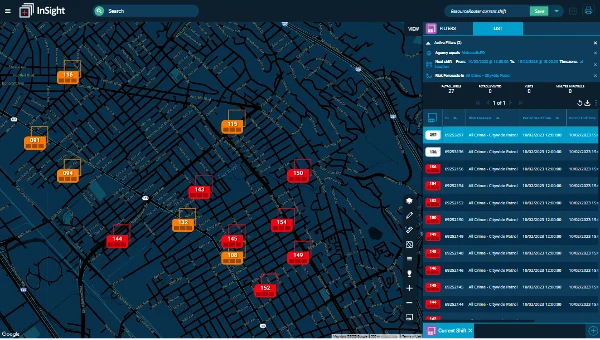
An example of an automated Directed Patrol Plan. With ResourceRouter, command staff and crime analysts have a daily, shift-specific patrol plan that may have previously taken hours to put together manually.
Police Patrol Software Key Feature # 2: Data-Driven Directed Patrols Ensure Officers Maximize Impact During Shifts
Impactful police patrol software doesn’t rely on “gut-based patrolling,” since it’s imprecise and can lead to larger community issues like over-policing. ResourceRouter provides officers with data-driven patrol plans that change daily and with each shift. This ensures officers are at the right place at the right time to maximize crime prevention and guard against over and under policing, while also building community trust and confidence by performing and documenting agency-prescribed light touch, and non-enforcement activities during their patrols.
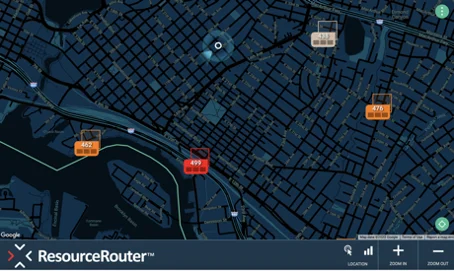
An automated directed patrol map is available on mobiles or MDTs. The system automatically generates color-coded directed patrol areas based on high-probability crime areas and includes a directed patrol meter to easily track visits.
As an example, let’s say a patrol officer is assigned to patrol an assault offenses area. The officer can quickly identify an assault offenses patrol area on the map based on the color code and view the directed patrol meter to determine if the area has already received the recommended dosage. The officer can also determine if the area is currently available for a visit, being patrolled by another officer, or currently time-restricted to spread crime deterrence efforts and mitigate over-policing.
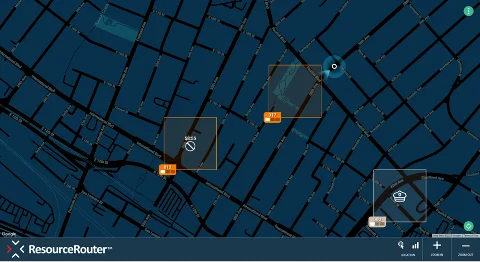
An example of the officer view showing an available area, a time-restricted area, and an occupied area.
Once the officer chooses the directed patrol area, they can then click on the Pre-Patrol Briefing to gather the necessary context and situational awareness prior to starting the patrol, including the risk terrain factors and relative crime risks in the area based on historic crime data. For example, in the screenshot below, a patrol officer will see that in addition to assault offenses, there have been burglaries, motor vehicle thefts, and larceny in the area. They will also be made aware of other risk terrain factors that could have an impact on the overall crime level in the vicinity, such as the location’s proximity to highways as well as density and distance to bus stops in the area.
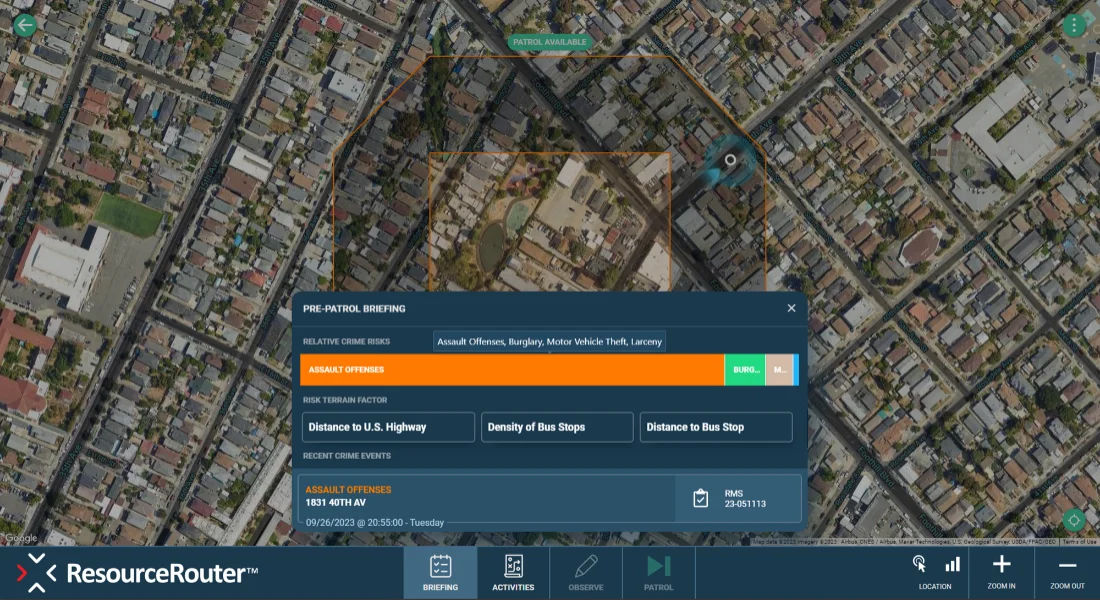
An example of a pre-patrol briefing for an Assault Offense crime type.
Once the officer decides to initiate a session in the area, they will click on the “Activities” tab to select the primary activity they will engage in during their visit. Agencies can customize the recommended activities presented to the officer based on crime type. Some examples of activities that agencies have employed include reaching out to a co-responder to help de-escalate a situation, visiting businesses in the area, or placing door hangers in the area to provide pertinent information to community members.
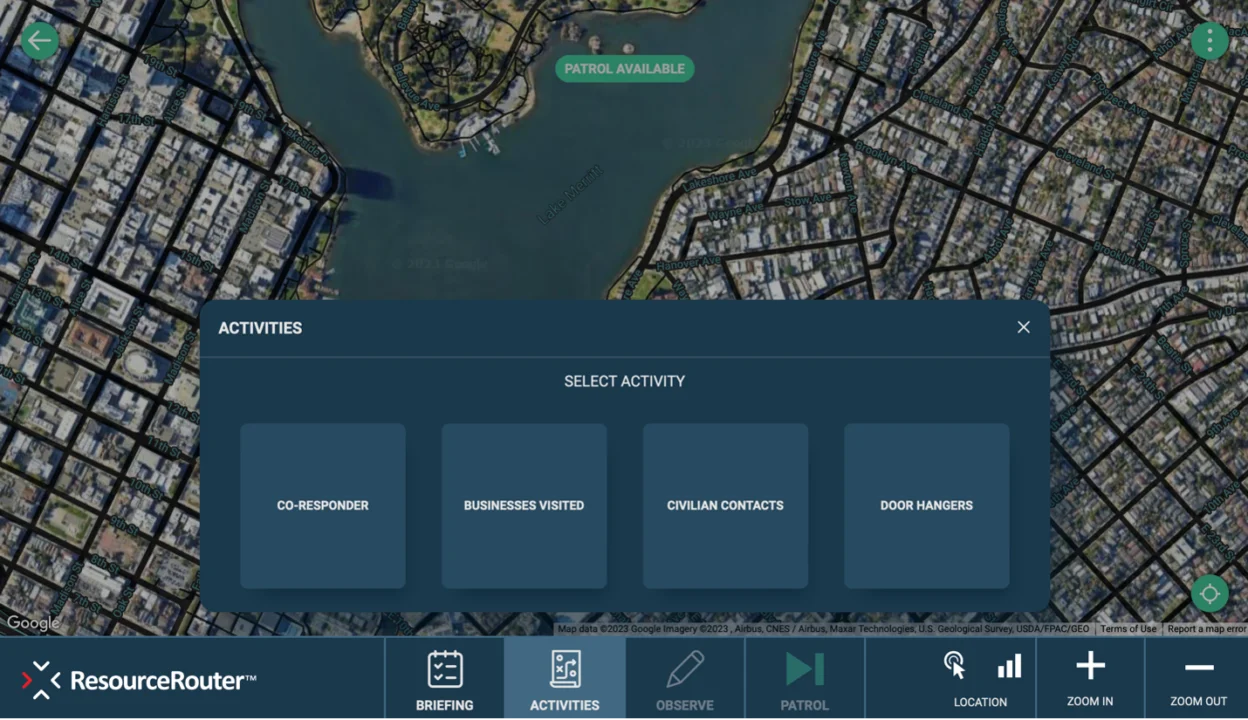
Additionally, officers can select from an agency-defined set of observations to document relevant observations or additional activities while on patrol. This can include community engagements, the number of businesses visited, or more general observations that could potentially pose a public safety risk, including graffiti, broken streetlights, et cetera. This information can help direct future police strategy or be shared with other relevant city agencies, such as the Department of Public Works, for follow-up.
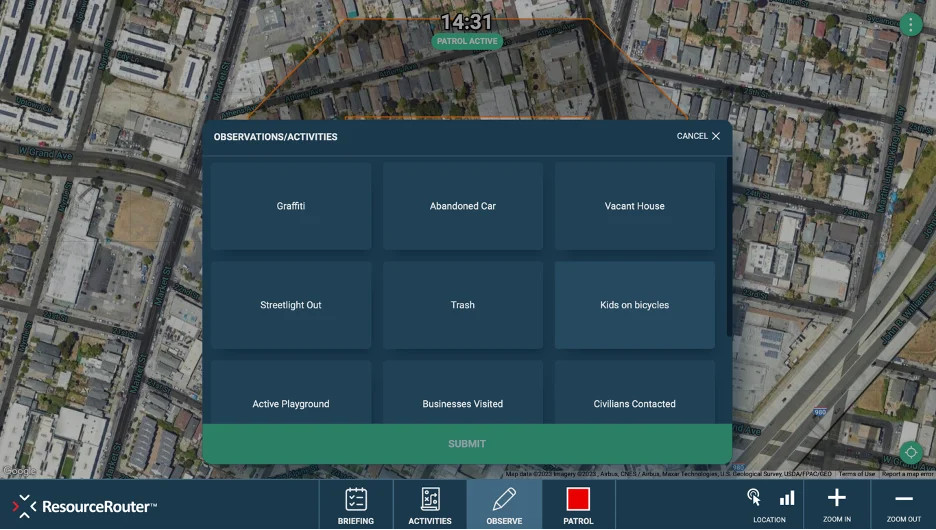
With the above features incorporated into ResourceRouter’s data-driven directed patrols, officers are better equipped to be proactive and efficient in their crime prevention efforts by saving time, increasing precision and impact, and demonstrating accountability during a busy patrol shift.
Police Patrol Software Key Feature # 3: Detailed Reporting in InSight for Increased Accountability
Detailed reporting is critical for increased accountability.
Agencies lacking police patrol software don’t have a reliable means of knowing where their officers spend their uncommitted time and the types of crime prevention activities they are employing in their crime prevention efforts. This lack of accountability puts them at risk of increased scrutiny from the community.
With ResourceRouter’s comprehensive reporting functionality, line-level supervisors and command staff can gain comprehensive insight into how officers are spending time on shifts, easily assess officer compliance, continuously evolve best practices based on a data-driven approach, and report on patrol metrics with greater accuracy and transparency. These reports include:
The Shift Report
In the InSight app, command staff can review the patrol boxes broken down by crime risk across a particular jurisdiction, as well as the current patrols and ad hoc areas that have either already been visited or are currently available. They can then hone in on any one patrol to see which officer visited the scene, as well as the activities and observations that the officer documented in reference to the visited patrol area. Furthermore, they can also assess the current dosage of patrol for any area to make sure that areas are not being over or under-policed.
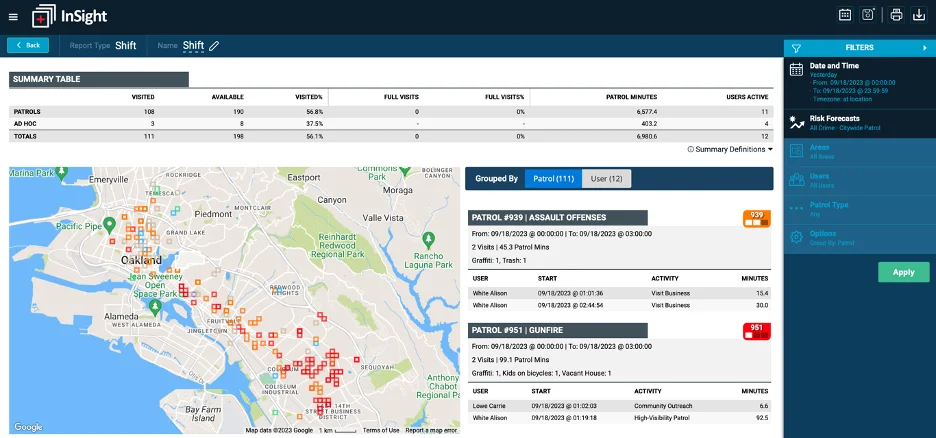
An overview of the Shift Report in InSight. To the left: a map of the jurisdiction. The color-coded boxes signify different crime types. To the right: command staff can hone in on an individual patrol area to see which officer visited, as well as the relevant activities and observations the officer documented in the patrol area, and the current “dosage” of patrols at that location.
The Officer Report
The Officer Report provides insight into officer or team activity over time to evaluate performance against planned goals. The report includes details for each officer including patrol areas visited, activities conducted, observations made, and time spent in each patrol area. The report also provides a quick comparison of team activity. With this level of detail, command staff have the visibility needed to measure actual metrics against planned goals and make the most informed decisions about changes in strategy and resource allocation moving forward.
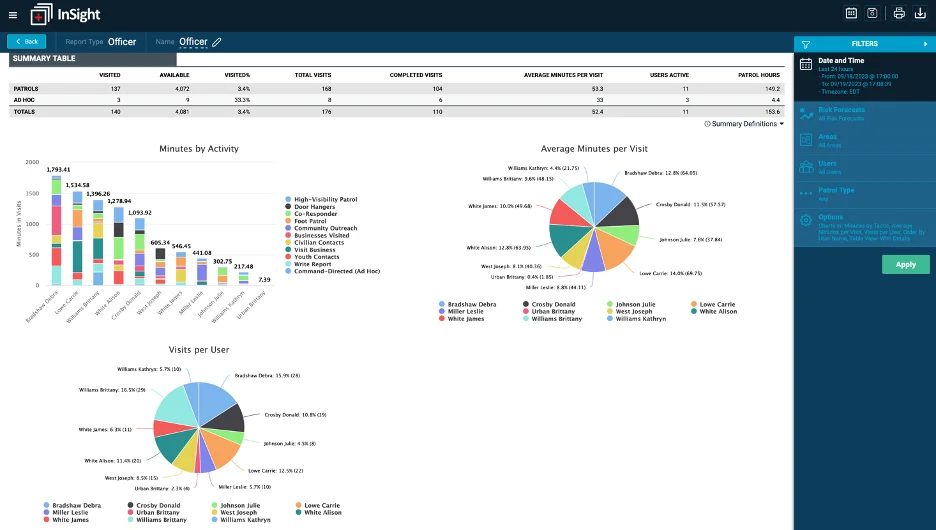
The Officer Report includes detailed officer activity for each visited directed patrol and ad hoc area.
The Activity Report
The Activity Report provides insight into which activity or strategies are being used most by officers to deter crime. The command staff can review visits by crime type, average minutes per visit, visits per activity, and an overall activity summary, making it easier to ensure that officers are implementing recommended activities and spending time efficiently and effectively over the course of their patrol shifts.
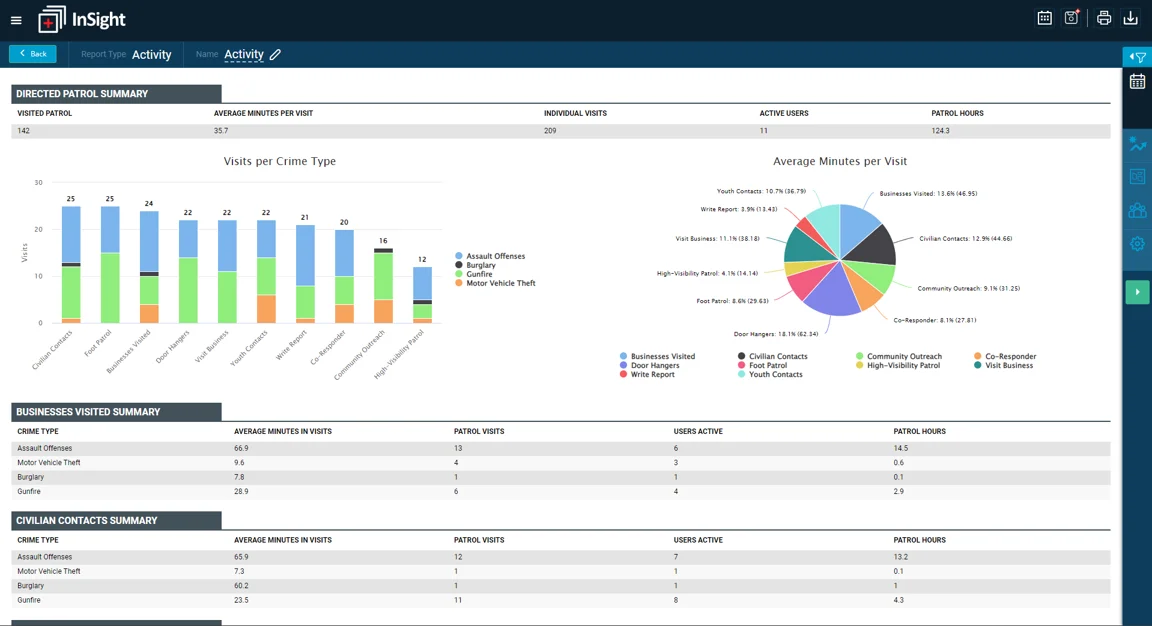
The Activity Report includes visits by crime type, average minutes per visit, visits per activity, and an activity summary.
The Crime Type Report
The Crime Type Report provides insight into which crime types have received the most focus and attention. The report allows command staff to evaluate visits by activity, visits per crime type, average minutes per visit, and a summary of activity per crime type. This level of reporting allows command staff to determine which activities were utilized most often for each crime type and more easily assess which activities may have the greatest impact per crime type.
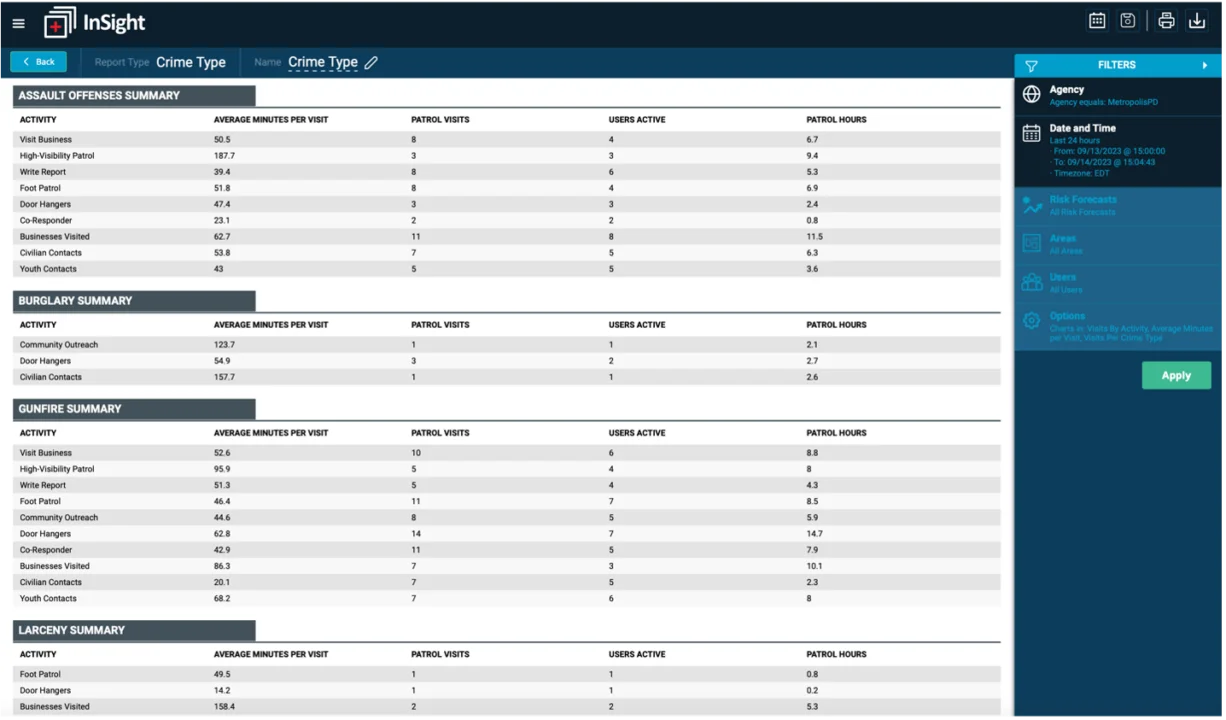 The Crime Type Report includes Visits by Activity, Visits per Crime Type, Average Minutes per Visit, and a summary of activity per crime type.
The Crime Type Report includes Visits by Activity, Visits per Crime Type, Average Minutes per Visit, and a summary of activity per crime type.
The Crime and Dosage Report
The Crime and Dosage report provides a high-level correlation between crime and dosage trends over time, enabling command staff and analysts to view progress and make informed, data-driven decisions moving forward.
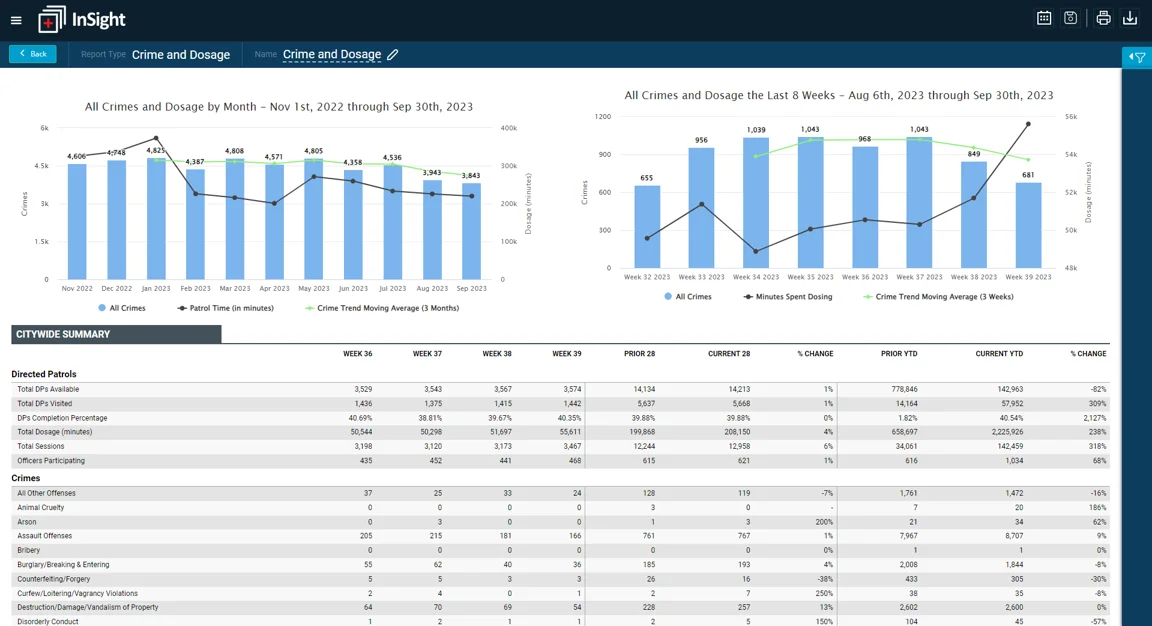
A comprehensive overview of crime type and dosage over a period of time.
Police Patrol Software Key Feature # 4: Ad Hoc Creation and Reporting for Impactful Crime Response
Given the reality of staffing shortages, high crime rates, and community complaints, command staff can find their agencies lacking an effective communication method to mobilize and align patrol resources around rapidly developing crime activities or special assignments, putting the community at risk.
With ResourceRouter Ad Hoc patrols, agencies can quickly direct and track the presence of resources in a designated area that they wouldn’t have been able to before. Such examples include an area that has become high-risk rather suddenly (which can happen in the event of a crime spree) or an area that may need special attention for a period of time due to a known upcoming event (such as a weekend-long music festival or a planned protest.)
Ad Hoc patrols help agencies effectively respond to newly identified crime patterns as well as prepare for special events. Let’s say for example that there’s been a string of car thefts in a certain area. With ResourceRouter’s Ad Hoc patrol feature, a crime analyst or command staff can create an ad hoc patrol to direct officers to the appropriate area, including notes to provide relative intel. The officer will be provided a Pre-Patrol Briefing similar to directed patrols, however, the briefing will also include the Ad Hoc Patrol name and type as well as any analyst or command staff notes. This capability allows agencies to be better equipped to swiftly allocate resources to recently developing crime events.
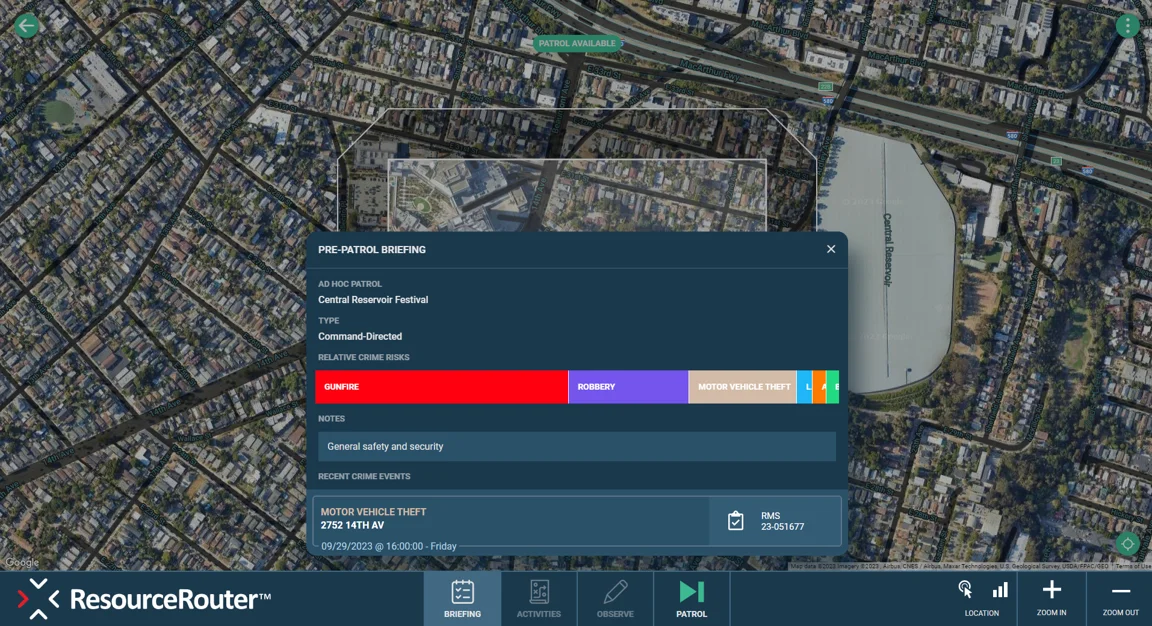
An Ad Hoc patrol in the ResourceRouter app. With this feature, crime analysts can designate an area to be a patrolling priority based on recent crime events (such as a string of car thefts in the same area).
Additionally, Ad Hoc boxes can be set up for special events, which is particularly fitting for general public safety and security scenarios, such as a neighborhood block party or weekend festival. An analyst can create an Ad Hoc area for a specific time and date, or over multiple dates and timeframes throughout the day.
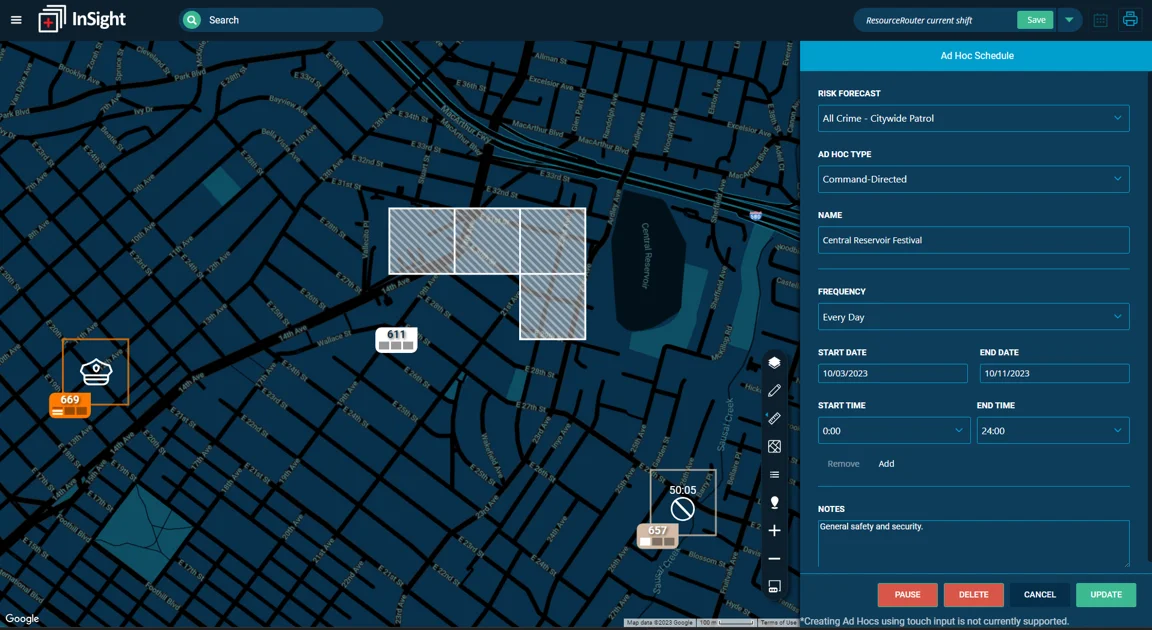
An Ad Hoc patrol area created for an upcoming special event.
Ad Hoc patrols also have robust reporting such that command staff can view activity across multiple ad hoc patrols in both a summarized and detailed view. This allows command staff to determine if appropriate resources were provided in the designated area(s).
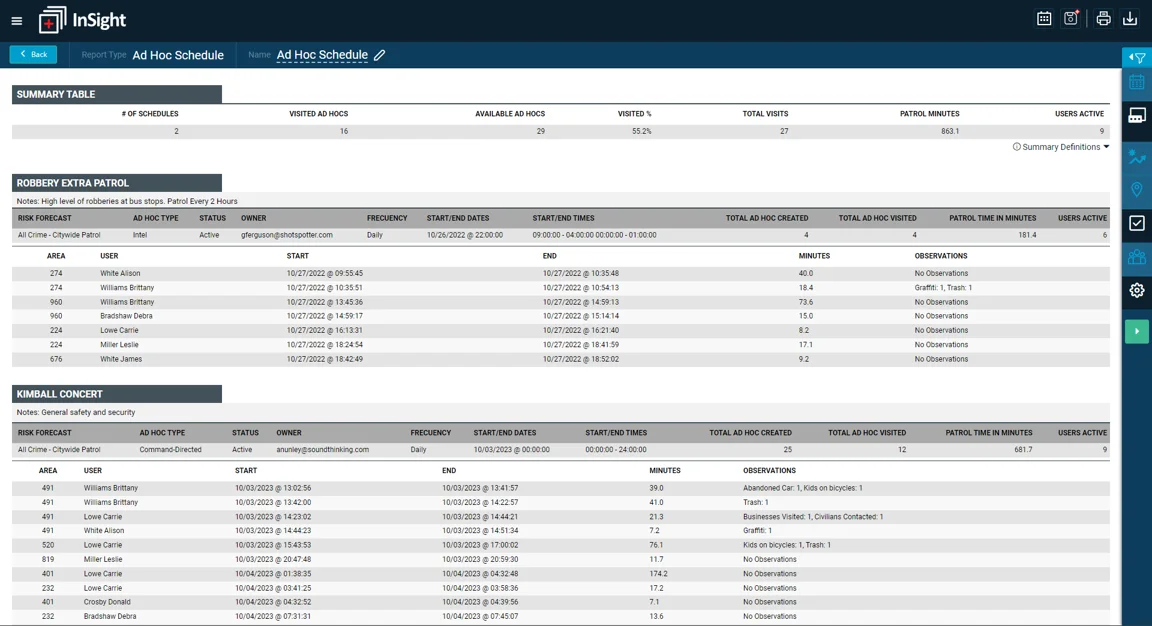
With Ad Hoc Schedule reporting, command staff can view Ad Hoc patrols in both a summarized and detailed view.
With the flexibility and reporting capabilities of the ad hoc patrol feature, ResourceRouter’s Ad Hoc patrol functionality helps agencies more quickly prepare, respond, and manage a variety of dynamic situations as they arise.
Police Patrol Software Key Feature #5: Impactful Community Events that Address Root Causes of Crime in Partnership with Key Stakeholders Outside of Law Enforcement
It can be difficult for command staff, constantly fighting fires with regards to navigating resource-constrained departments, high crime rates, and community complaints, to have the time and space to build out a holistic and proactive crime prevention strategy that works in tandem with key stakeholders outside of law enforcement.
ResourceRouter, however, is a police patrol software that manages to accomplish exactly this. Thanks to the system’s daily updated crime data, command staff are now better able to determine at-risk areas and then work in partnership with relevant non-law enforcement stakeholders to develop holistic crime prevention policies.
The Community Connections event in Springfield, IL is a good example of this concept in action. In 2022, the City of Springfield hosted Community Connections, an event for community members from a 49-square-block area that the ResourceRouter system identified as especially high risk. Small groups consisting of police officers, social services workers, public works employees, and more walked around the neighborhood, going door-to-door to find out what the city could do for them. In many cases, actions were taken right then and there, like filling in a trench that the resident had not been able to get the city to address previously. In addition, a variety of groups were present at the event, including representatives from school mentorship programs, a healthcare organization, a library, and more. This contributed to an improved sense of well-being in the community, and a greater sense of trust and camaraderie between law enforcement, community members, and other key organizations. “As long as I’m sitting in this seat, we’re going to be out in the community making sure they understand that we’re here to help, all that we can provide for them, and getting together with our other community partners to make that happen,” said Chief of the Springfield Fire Department Brandon Blough.
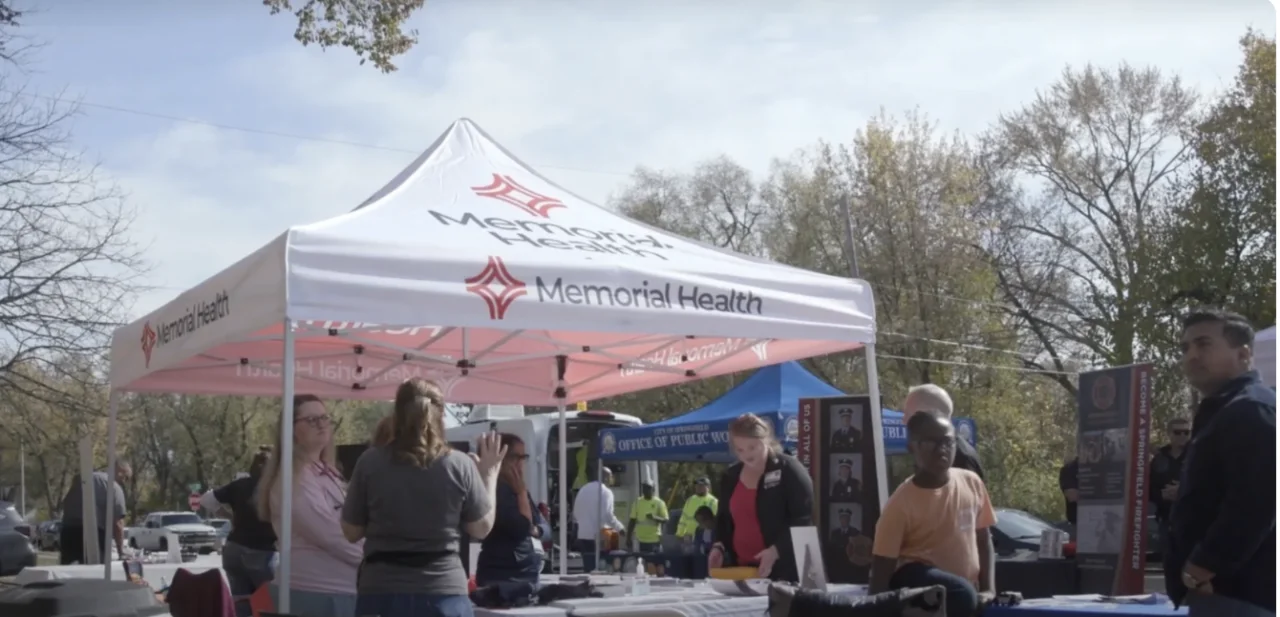
A picture from the Memorial Health booth at Community Connections.
Other Police Patrol Solutions
Simsi
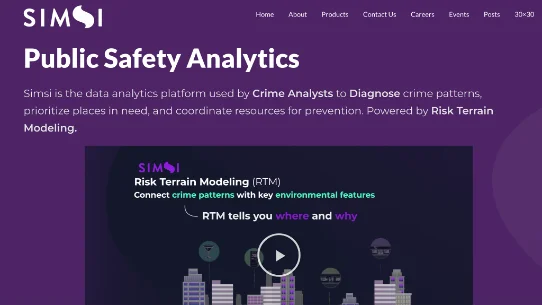
Simsi is a data analytics platform used to diagnose crime patterns, prioritize places in need, and coordinate resources for prevention. Powered by Risk Terrain Modeling, their software shows how people interact at particular places and times to create contexts and opportunities for specific behaviors and outcomes, such as crime. Their Risk Terrain Modeling software RTMDx™ is their flagship product. Unlike ResourceRouter, Simsi does not have a method to track user presence or activity in the patrol areas that they identify, and thus cannot report on dosage or officer activity in an identified area or the impact that this may have on crime.
LexisNexis® Risk Solutions Community Crime Map

LexisNexis® Risk Solutions Community Crime Map is not a direct comparison to ResourceRouter, but it is an online tool and mobile app that promotes cooperation and communication between police and the public. It allows law enforcement to share selected crime data and automatically alerts citizens about recent local crime activity to encourage community policing.
A Checklist for Assessing the Best Police Patrol Software
- Does the system provide readily available automated reports that display metrics around officer activities, crimes addressed, as well as time spent in patrol areas, resulting in up to 80% time savings for crime analysts each week?
- Does the system utilize historic crime data as well as objective data to produce automated directed patrols that are constantly refreshed with the most up-to-date data?
- Does the system provide comprehensive reporting functionality so that line-level supervisors and command staff can gain comprehensive insight into how officers are spending time on shifts, easily assess officer compliance, and continuously update best practices with increased accountability?
- Does the system provide Ad Hoc patrolling capabilities that enable command staff to better prepare, respond, and manage a variety of dynamic situations as they arise?
- Does the system provide an accessible way to collaborate with stakeholders outside of law enforcement to implement meaningful and holistic crime prevention initiatives?
Ready to Try ResourceRouter?
It’s critically important for resource-strapped agencies to leverage force-multiplying technologies so that they can maximize limited patrol and analyst resources for the highest impact. ResourceRouter can help.




